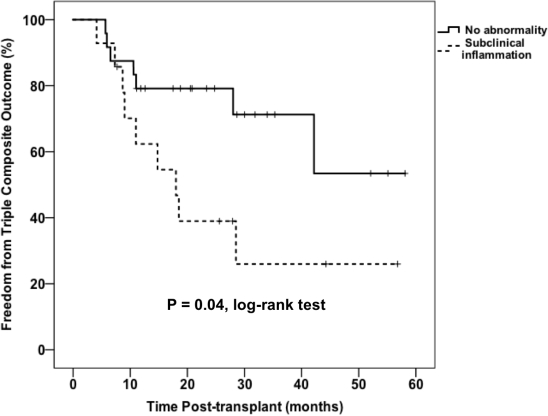Predictors of Early Rejection and Allograft Failure in Pediatric Kidney Transplantation: Impact of Histology and Behavior.
University of Alabama at Birmingham School of Medicine, Birmingham.
Meeting: 2016 American Transplant Congress
Abstract number: 231
Keywords: Biopsy, Inflammation, Outcome, Pediatric
Session Information
Session Name: Concurrent Session: Kidney: Pediatrics
Session Type: Concurrent Session
Date: Monday, June 13, 2016
Session Time: 2:30pm-4:00pm
 Presentation Time: 3:18pm-3:30pm
Presentation Time: 3:18pm-3:30pm
Location: Room 311
Background: Early inflammatory events that lead to allograft dysfunction are often missed by creatinine-based estimates in children. Surveillance biopsies can detect early allograft dysfunction due to cellular and humoral alloimmunity. While subclinical rejection and inflammation have been associated with poor graft outcomes in adult recipients, the impact of these subclinical findings in children remains unclear.
Objective: We tested the hypothesis that children with early subclinical inflammation have inferior outcomes after kidney transplantation.
Design/Methods: We retrospectively reviewed all surveillance biopsies performed at 3 and 6 months post-transplant from August 2008 to December 2014. Median (IQR) clinical follow-up was 35 (21-62) months. The primary outcome was a composite of death, acute rejection, or graft loss by 5 years. The primary exposure was borderline or subclinical rejection on any surveillance biopsy. Secondary exposures included C4d deposition in peritubular capillaries (C4d+) and early non-adherence in the first 6 months post-transplant. Outcomes were analyzed with Fisher's exact test, student's t test, and Kaplan-Meier methods.
Results: We analyzed 75 subjects with a median (IQR) age at biopsy of 12 (6-17) years. The cohort included 50% black and 75% deceased donor recipients. Overall, 37% of subjects had subclinical inflammation (22% borderline changes and 15% subclinical rejection). The composite outcome occurred in 34% of all subjects. Those with subclinical inflammation had a higher incidence of the composite outcome by 5 years, but most occurred within 24 months (Figure). By Kaplan-Meier analysis, both early non-adherence and C4d+ (both P<0.05) were associated with higher incidence of the composite outcome.
Conclusions: Early subclinical inflammation was frequently detected in pediatric kidney transplant recipients and was associated with a high incidence of rejection and graft failure within 24 months post-transplant. Early non-adherence and C4d deposition may also contribute to early allograft outcomes in children. Focusing on improved early management may reduce graft failure in pediatric recipients.

CITATION INFORMATION: Seifert M, Yanik M, Mannon R. Predictors of Early Rejection and Allograft Failure in Pediatric Kidney Transplantation: Impact of Histology and Behavior. Am J Transplant. 2016;16 (suppl 3).
To cite this abstract in AMA style:
Seifert M, Yanik M, Mannon R. Predictors of Early Rejection and Allograft Failure in Pediatric Kidney Transplantation: Impact of Histology and Behavior. [abstract]. Am J Transplant. 2016; 16 (suppl 3). https://atcmeetingabstracts.com/abstract/predictors-of-early-rejection-and-allograft-failure-in-pediatric-kidney-transplantation-impact-of-histology-and-behavior/. Accessed December 16, 2025.« Back to 2016 American Transplant Congress
